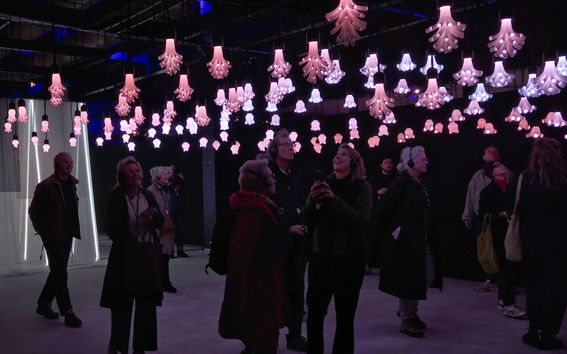Kollegi collective illuminated Dutch Design Week with biodiversity lamps

In October, the annual Dutch Design Week (DDW) brings together designers and the public from around the world for a ten-day event full of exhibitions. This year, Aalto University was again represented at DDW with several different exhibitions. One of them was a large lighting installation Evolumination, which uses algorithmic design to welcome visitors at the entrance to the Microlab exhibition space.
Severi Uusitalo of the Kollegi collective, which created the work, is Professor of Industrial Design at the Department of Design. All members of the group, designer Sami Markkula and architects Tina Čerpnjak and Kane Borg, work at Aalto as graduate students and lecturers. The project also received funding for procurement and travel from Aalto's Department of Design, as well as from the Asko Foundation.
"The work presents several perspectives through design. It embodies biodiversity and the impact of the environment on the evolution of species, even their differentiation. Different corners of the space represent different growing conditions, which is why they have different types of lighting," says Uusitalo.
The work consists of 144 lamps of different shapes hung in a 6x6 m space. Microlab's audience walked under and among the luminaires. The shape of the luminaires resembles the organicity of plants and organisms, leaving open room for interpretation by the audience. LED-based luminaires can be controlled.
"In the room, the different bulbs basically act like a big screen, so we can use the lights to run animations. This allows the background theme to be conveyed more strongly. On the other hand, the work can be experienced as an immersive spatial experience and you can just live it," says Uusitalo.
Microlab received an average of 3,000 visitors a day, each of whom passed through the work. So over a ten-day period, 30 000 people visited the work.

3D-printed organic shapes
In their discussions, visitors described their impressions of marine organisms such as corals, roots, mushrooms or even internal organs. The shapes of the luminaires are meant to leave room for the viewer's own interpretation.
"The idea was not to lock the viewer's thinking but to give clues and inspire, and we succeeded in that, based on the feedback. The work is allowed to be ambiguous and raise questions without preconceived answers. This takes the work in the direction of experimental design and art experience, although the design development angle is equally interesting to us professionally," Uusitalo emphasises.
The lamps are individual pieces 3D printed on filament printers at Väree's print shop from PLA material.
"At best, 20 printers were working on these lights simultaneously during the school summer break. It took up to 36 hours to print one of them, after which the lights had to be cleaned and assembled. The journey from algorithmic design to realised work was a good reminder of the limits of the physical world."
Severi UusitaloThe idea was not to lock the viewer's thinking but to give clues and inspire, and we succeeded in that, based on the feedback.
Interaction with the public was inspiring
The discussions with the audience were an inspiring part of the exhibition. Some visitors were excited by the idea of the influence of growth factors on the differentiation of the same species, which was most evident when looking at the specimens in the corners of the work. The discussions led to talk of the different concept definitions, even where a coral in a shape variant has become an octopus or a heart.
"It was great to observe how people got excited when they noticed the evolution in the shapes of the luminaires — they started pointing out the different lines of growth. Of course, we also received enquiries about where to buy the lamps. However, it was important to note that the lamps were part of the exhibition and part of a larger installation."
The piece was designed for DDW and it has not yet been decided where it will move next. According to Severi Uusitalo, Evolumination may also be seen at Aalto University campus in the future.
More information:
Severi Uusitalo, Professor of Industrial Design
- Published:
- Updated:
Read more news

Pengxin Wang: The internship was an adventure filled with incredible research, unforgettable experiences, and lifelong friendships.
Pengxin Wang’s AScI internship advanced AI research, fostered global friendships, and inspired his journey toward trustworthy AI solutions.
Major grant from the Kone Foundation for modern architecture research - Laura Berger's project equates building loss with biodiversity loss
Aalto University postdoctoral researcher Laura Berger and her team have been awarded a 541 400 euro grant from the Kone Foundation to study the effects of building loss on society and the environment.
14 projects selected for seed funding to boost collaboration between Aalto, KU Leuven, and University of Helsinki
The funded projects lay the groundwork for future joint research endeavors, reinforcing the strategic partnership’s goal to fostering impactful and interdisciplinary collaboration.